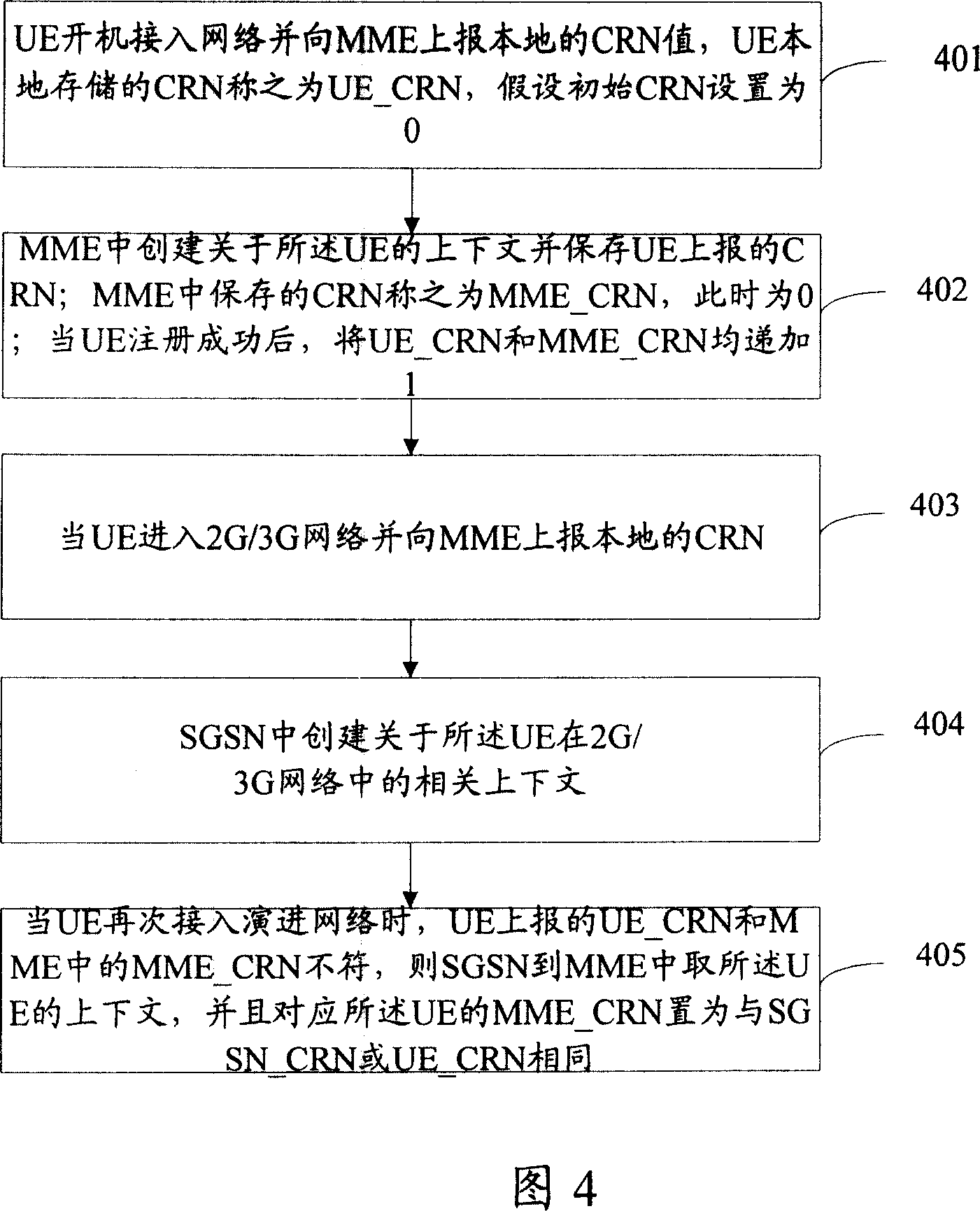Context negotiation method
A context and entity technology, applied in the field of mobile communication access
- Summary
- Abstract
- Description
- Claims
- Application Information
AI Technical Summary
Problems solved by technology
Method used
Image
Examples
Embodiment 1
[0110] Embodiment 1: UE initially accesses 2G / 3G network.
[0111] The process of this embodiment is shown in Figure 3, including the following steps:
[0112] Step 301: The UE starts up and accesses the 2G / 3G network and reports the local CRN value to the SGSN, which is called UE_CRN, assuming that the initial CRN is set to 0;
[0113] Step 302: Create a context about the UE in the SGSN and save the CRN reported by the UE; hereinafter, the CRN saved in the SGSN is called SGSN_CRN, which is 0 at this time; when the UE is successfully registered, according to the CRN update algorithm, the UE_CRN Both UE_CRN and SGSN_CRN are incremented by 1, and both UE_CRN and SGSN_CRN become 1;
[0114] Step 303: The UE enters the evolved network and reports the local CRN to the MME;
[0115] Step 304: The MME creates relevant context about the UE in the evolved network; the specific process is as follows: the MME first compares the CRN reported by the UE with the CRN of the UE stored local...
Embodiment 2
[0119] Embodiment 2: UE initially accesses the SAE / LTE network.
[0120] The process of this embodiment is shown in Figure 4, including the following steps:
[0121] Step 401: UE boots up and accesses the network and reports the local CRN value to the MME. The CRN stored locally by the UE is called UE_CRN, assuming that the initial CRN is set to 0;
[0122] Step 402: Create a context about the UE in the MME and save the CRN reported by the UE; the CRN saved in the MME is called MME_CRN, which is 0 at this time; when the UE is successfully registered, the UE_CRN and MME_CRN are both updated according to the CRN update algorithm. Incrementing by 1, both UE_CRN and MME_CRN become 1;
[0123] Step 403: The UE enters the 2G / 3G network and reports the local CRN to the MME;
[0124] Step 404: Create relevant context about the UE in the 2G / 3G network in the SGSN; the specific process is as follows: the SGSN first compares the CRN reported by the UE with the CRN of the UE stored loca...
Embodiment 3
[0127] Embodiment 3: Under the condition that the SGSN remains unchanged, the UE initiates the RAU process in the 2G / 3G network.
[0128] After the UE sends a RAU request to the SGSN, the SGSN will judge whether the CRN value reported by the UE matches the CRN value stored internally. If it matches, the SGSN does not need to initiate the process of requesting the context from the MME; otherwise, it needs to request the relevant context from the MME. Detailed process See as shown in Figure 5a or Figure 5b, including the following steps:
[0129] Step 501: UE sends a RAU request carrying UE_CRN to SGSN; RAU also includes old U-TMSI, old U-RA and / or S-TMSI, S-RA, which are irrelevant to the present invention;
[0130] Step 502: The SGSN judges whether the received UE_CRN matches the locally stored SGSN_CRN, and if it matches, it does not need to ask for the context from the MME, and proceeds to the normal RAU process, otherwise, executes step 503;
[0131] Step 503: SGSN sends a...
PUM
 Login to View More
Login to View More Abstract
Description
Claims
Application Information
 Login to View More
Login to View More - R&D
- Intellectual Property
- Life Sciences
- Materials
- Tech Scout
- Unparalleled Data Quality
- Higher Quality Content
- 60% Fewer Hallucinations
Browse by: Latest US Patents, China's latest patents, Technical Efficacy Thesaurus, Application Domain, Technology Topic, Popular Technical Reports.
© 2025 PatSnap. All rights reserved.Legal|Privacy policy|Modern Slavery Act Transparency Statement|Sitemap|About US| Contact US: help@patsnap.com



